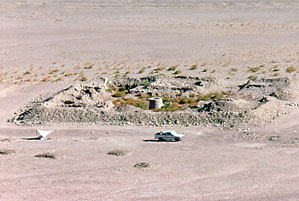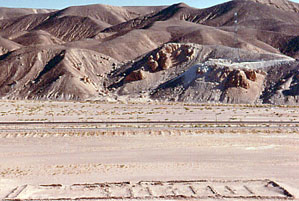|
In one of the many places called Abu Qreiya (this
one is in Wadi Qena about 40 km. before that debouches in the Nile valley)
is this hydreuma. In the centre the modern, concrete well can be
seen that was sunk here in the beginning of the 20th century:
|
|
Just west of the hydreuma in Abu Qreiya are
these large animal lines. Against the backdrop of the modern railway and
the even more recently built asphalt road, they nicely illustrate the continuous
urge which men feels to travel:
|
|
|
|
|

|
|

|
|
|
|
|
|
|
|
|
Objective of visit:
|
|
To draw a measured plan of the site and study the surface
remains (including the ceramic finds). |
|
Date of visit:
|
|
- June 1999 |
|
Fellow visitors:
|
|
Prof.Dr. Steve Sidebotham (University of Delaware). |
| Results: |
|
A survey was performed using the Global Positioning System
and a theodolite with Electronic Distance Measuring. Off-site assistance
was given by pottery expert Dr. Roberta Tomber (Museum of London). No excavations
took place. A full publication of this site is pending. |
| Approximate position and date
of the site: |
|
The hydreuma at Abu Qreiya is in the north-western
part of Egyptian Eastern desert, just north of the Qena-Safaga asphalt
road and about 40 km. east of Qena in the Nile valley. Surface pottery
dated to the beginning of the Roman period (ca. 30 BC- 300 AD). |
| Short description of the site: |
|
The hydreuma in Abu Qreiya was a stop on the ancient
road between the Nile and the Red Sea where travelers could find water,
food and shelter for the night. Judging by the size of the ancient remains,
Abu Qreiya was important for the traffic, as the area obviously still is
today. |
| Additional remarks: |
|
About 500 metres west of this hydreuma are the
remains of a second one which is heavily disturbed by the modern railway
that passes through the southern half of it. Our work was sponsored by
the University of Delaware and private donors. |
| HOME |
|
|
 |
|
|